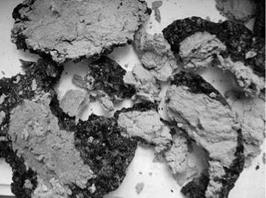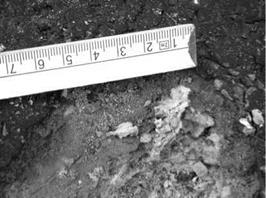STABILIZER LUMPS
Stabilizer lumps occur rarely, but sometimes they bring fairly unpleasant consequences. The problem lies in the fact that symptoms may only be seen some time after the placement of an SMA course. Results such as the following are quite spectacular:
• Initial formation of bulging spots in a newly made course
• A spot of mixture that separates from the mat
Both cases are caused by lumps or pieces (Figure 11.6) of an undistributed (unmixed) stabilizer of loose fibers. Moisture absorbed by a stabilizer is able to lift
|
|
|
|
|
|
FIGURE 11.7 Stabilizer lumps incorporated into an SMA course. (Photo courtesy of Marco Schunemann.) |
|
FIGURE 11.8 The closed structure of an SMA course over a large area. (Photo courtesy of Krzysztof BlaZejowski.) |
an SMA course enough to be discernible to the naked eye. It also causes the mixture to ravel and create pot holes (Figure 11.7). These situations may happen as a result of the following:
• Wet, loose fibers were applied.
• Loose fibers was added into the pugmill too late—namely, after binder dosing.
• Wet-mixing time was excessively shortened.
• Stabilizers of poor quality were used.











Leave a reply